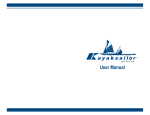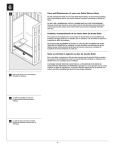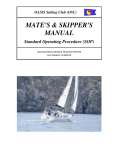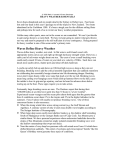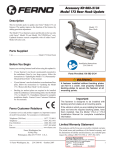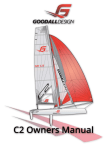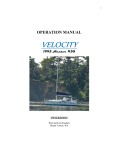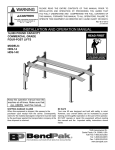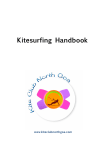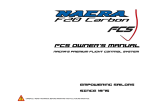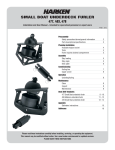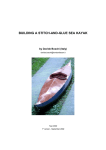Download User Manual - TopKayaker Shop
Transcript
www.kayaksailor.com TM User Manual www.kayaksailor.com Contents Releases and Agreements 1 Warning and Safety Precautions 2 Diagrams of rig List of Parts Assembly out of the box 5 5-10 11-14 Working Features 14-20 Sailing Basics 20 21 - 24 Installing the mounting kit 25-27 Securing the rig on the boat 28-29 Removal for storage 29-30 Transporting your rig 30 Maintenance and Care 31 Glossary of terms Warranty Your new Kayaksailor represents the very latest development in sailing rigs for paddle craft. 3-4 Mounting the rig for water trials Water trials Congratulations on your decision to purchase the Kuvia Kayaksailor, and welcome to the enthusiastic family of Kayaksailor owners. 32-34 Here at Kuvia, we love to test and have fun with the sailing rigs we create. From this hands on experience comes a unique understanding of how to maximize the performance of our products. We would like to share this knowledge with you. Even if you are an experienced sailor, we suggest that you read this manual thoroughly before using the Kayaksailor for the first time. You will find the instructions clear and easy to follow, and a few minutes' study will assure your success from the start. ! If you are unfamiliar with kayaking or re-entering a kayak from the water, seek professional instruction on proper re-entry techniques. If you are new to sailing or kayaking, please be advised that this manual is not intended to teach you how to sail or kayak. We recommend contacting your local kayak shop, college, yacht club, sailing club, or coast guard auxiliary for instruction on kayaking, sailing, and marine safety. 35 Take your time studying this manual, and have fun. We'll see you out on the water. Kuvia LLC. www.kayaksailor.com RELEASES AND AGREEMENTS By assembling and /or using this product, you are agreeing to: 1) be bound to the terms set forth below; and 2) require anyone using this product to be bound by such terms. If you are unwilling to be bound by these terms, return this product (before use) for a full refund. ! WARNINGS & SAFETY PRECAUTIONS • Kayaksailing can be dangerous. • If you are under 18, you should have your parents or legal guardian read these warnings and instructions. You should not use this product unless you are under proper guidance and supervision. • Do not use this product if you are under the influence of alcohol, drugs or medications. Release of Liability, Claim Waiver and Assumption of Risk Agreement • Always wear a nationally approved personal flotation device. Release and Waiver of Claims Agreement: • Understand your physical and skill limitations. In consideration of your use of this product, you hereby agree to the following, to the fullest extent permitted by law: • Dress appropriately for the water temperature. Prolonged exposure to cold water will result in hypothermia. To waive any and all claims that you have or may in the future have against Kuvia LLC or any of its agents, resulting from use of this product and any of its components.To release Kuvia LLC or any of its agents from any and all liability for any loss, damage, injury or expense that you or any users of this product may suffer, or that your next of kin may suffer, as a result of the use of this product, due to any cause whatsoever, including negligence or breach of contract on the part of Kuvia LLC or any of its agents, in the design or manufacture of this product. Binding Effect of Agreement: In the event of your death or incapacity, this Agreement shall be effective and binding upon your heirs, next of kin, executors, administrators, assigns and representatives. Entire Agreement: In entering into this Agreement, you are not relying upon any oral or written representations other than what is set forth in this Agreement. • The use of this product exposes the user to many unavoidable and unexpected risks, dangers and hazards. Use of this product and any of its components involves certain inherent risks, dangers and hazards, which can result in serious personal injury or death. In using this product you freely agree to assume and accept any and all known and unknown risks of injury while using this equipment. The risks inherent in the sport can be greatly reduced by abiding by the Warnings and Safety Precautions listed in this User’s Guide and by using common sense. • Never use this product with worn lines. • Always observe local rules and regulations when using this product. • Never learn to use this product in more than 10 knots of wind. • Practice raising and lowering the sail and self rescue techniques before using this product on the water. • Never use this product in high winds. • Never allow anyone else to get close to the rig when raising and lowering the sail. The sliding mast car and movement of the spars can cause injury. • Only use this product when you are in a sitting position. • When you capsize, stay with your boat. This can not be emphasized enough. Being separated from your boat can be fatal. • Never use this product on the water unless you know how to swim. • Never act in a careless manner when using this product. • Misuse of this product can cause serious injury or death. • You are responsible for your own safety, and the safety of others around you when using this product. • Never allow anyone who is not familiar with kayaksailing to use this product without experienced assistance. [1] • Check your equipment prior to each use for signs of wear or failure. • Always use extreme caution when using this product. • Only use this product if you are in good physical health; be honest with yourself. Assumption of Risk: •The Kayaksailor should not be used in breaking waves, strong currents or extreme conditions. • Never use this product in thunderstorm and lightning conditions. • Never use this product in wind conditions that are above your ability level. • Never use this product near or on the water in offshore wind conditions unless you are an expert paddler. • Only use this product when you have clear space downwind, and on both sides of your craft. • Do not sail your craft around swimmers. • Never use this product on crowded waterways. • Choose a location free of breaking waves, strong currents, or extreme conditions. • Avoid boating alone. • Rinse your Mast Track with fresh water and lubricate after every session. An adequately lubricated mast track will help the rig fold quickly in an emergency situation. [2] www.kayaksailor.com Diagrams KEYHOLE CLEATS GOAL POST TOPMAST SHROUD BATTENS MAST HEAD SAIL MAST REEFING POINTS MAST RINGS TOPMAST DOWNHAUL BUNGEE FORESTAY REEFING OUTHAUL HALYARD HALYARD SHROUD GOOSENECK MAIN SHEET MAST CAR HALYARD PULLEY MAST CAR CONTROL LINE MAST TRACK CAMLOCK WEBBING CROSS TUBE LEEBOARD LEEBOARD CONTROL KNOB MAST CAR HALYARD BOOM HALYARD PULLEY OUTHAUL MAST CAR BUNGEE SHROUD RETRACTION BUNGEE PUSH ROD LEASH MAST TRACK PUSH RODS DOWNHAUL/ BOOMVANG MAIN BODY TUBE [3] WINDOWS MAST LEEBOARD FOAM PADDING LEEBOARD CONTROL KNOB [4] CROSS TUBE www.kayaksailor.com list of parts A )1 Sail Rig Main Body with Sail Cover Remove split ring and clevis pin from the center of the cross tube. B) 2 Leeboard Assemblies C) 1 Aluminum Cross Tube with Clevis Pin and Split Ring D) 2 Fiberglass Push Rods E) 2 Shroud Rings with Thumb Screws Slide the cross tube halfway into the main body tube until the holes align. F) 1 Mounting Kit : Includes 4 Stainless Steel Eye Straps, 9 SS Machine Screws, 9 SS Washers, 9 SS Lock Nuts, 9 Aluminum Tri-Grip Blind Rivets G) 1 Webbing Kit: Includes 2 CamLock Buckle Straps, 2 Loop Webbing Straps, 1 Long (Under-the-Hull) Loop Webbing Strap H) 1 Carry Bag Assembly Out of the Box: Remove all items from box and lay them out on a clean flat area. D E G Insert the clevis pin from below C F A B H [5] Secure with the split ring. [6] www.kayaksailor.com Slide one Camlock webbing strap onto one side of the cross tube. Slide the longest webbing strap onto the other side of the cross tube. The remaining straps will be used at a later time with the mounting kit. Untie the shrouds. There are two shrouds and two shroud rings. Attach one shroud to each shroud ring. The knot on the shroud should sit inside the upper notch of the shroud ring facing out. Slide the shroud ring onto the cross tube and tighten the thumb screw a couple of turns so that it " just" enters the hole in the cross tube. Note: The knot should be on the top of the cross tube as shown. [7] The shrouds should look like this. Insert the push rod into the leeboards trailing edge and secure with the split ring. Slide the leeboard assembly all the way into the cross tube. Note: If you have trouble inserting the leeboard assembly into the cross tube, check to see if the thumbscrew is protruding into the tube. If this is the case, back out the thumbscrew a little and try again. [8] www.kayaksailor.com Check these items before proceeding: 1. The split ring for the cross tube is located on the upper surface of the main body tube. Tighten the leeboard control knob. (Hand tight) 2. One side of the cross tube has a Camlock webbing strap and the other side has the longest webbing strap. 3. The shrouds are not crossed. 4. The knot on the end of the shroud is in the upper notch of the shroud ring facing out. 5. The knot at the end of the shroud should be on the top of the crosstube. 6. The leeboard control rods are inserted into the leeboards and secured with the split rings. 7. The leeboard assemblies are inserted fully into the crosstube. Tighten the shroud ring thumb screw. 8. The leeboard control knob and the shroud ring thumb screw are both tight. Repeat this process for the leeboard assembly on the other side. The assembled rig should look like this. [9] [ 10 ] www.kayaksailor.com Mounting the rig for water trials In order to determine an acceptable mounting position, the rig should initially be attached to the boat only temporarily. This may be done with mylar packaging tape and the longest, (49", 124cm) webbing strap. With a pencil or wax marker, mark the deck of the kayak under the cross tube near the gunwales. Pass the webbing strap under the hull and secure with the CamLock buckle located on the other side of the cross tube. Tighten the webbing straps so the main body tube is in the center of the boat. But don’t over tighten. Positioning Note: If you over tighten the webbing strap you may bend the cross tube. Lay the folded rig on the deck of the kayak. If your boat has a domed deck, be sure to use mylar packaging tape to prevent the rig from shifting during water trials. Sit inside your kayak and lean forward as if touching your toes. Note: It's important to be able to reach the mast head from the cockpit in order to help gather the sail and position it between the goal posts. The mast head and sail should be within your grasp. Ideal rig placement should be close enough to reach the sail and far enough in front of you to allow for a clean paddling stroke. This should be a good rig position for testing. [ 11 ] The tape should be passed under the hull and secured around both ends of the cross tube. [ 12 ] www.kayaksailor.com Secure the front of the rig with the forward tie-down line to any existing deck hardware. If you can’t find a good place to tie it, don’t worry. Set the leeboard assemblies to the width of your boat. The leeboard control knob should be tightened so the leeboards will remain in the raised position. Tighten the shroud ring thumb screw to lock the leeboard assembly in place. Becoming familiar with the working features. Use mylar packaging tape at the level of the forestay eyebolt around and under the bow. The Magic Track™ mast step This unique feature allows the mast and sail to be raised or lowered from the cockpit. Pulling the mast car aft along the track raises the mast. A bungee line pulls the mast car forward lowering the mast. Attention: Keep yourself and others away from the rig while raising and lowering the sail. The sliding mast car and moving spars can cause injury. Place the leeboard control rods on the deck, unwind the 3 sail control lines and lead them into the cockpit. The goal posts Check the security of the rig by trying to shift it from side to side. If it moves more than 2" use more packaging tape. [ 13 ] The goal posts hold the sail in place when the rig is folded. [ 14 ] www.kayaksailor.com The key hole cleats Sail reefing Reefing is the ability to reduce the size of the sail area in overpowering conditions. Ideally, this should be done prior to launching your boat. This easy to use cleat is located on the rear section of the main body tube under the goal posts. It is used to secure two lines, the mast car control line and the halyard. To cleat a line pass it through the hole and drop the knot in the bottom of the slot. Raise the mast Take the outhaul reefing line and thread it through the end of the boom and secure. Gather the sail together and tie the reefing lines under the boom. The main sheet cleat The main sheet cleat is a single cam cleat that allows the main sheet to be locked in postion. The sail can be deployed or folded while reefed. The leeboard assemblies The main purpose of the leeboards is to reduce the sideways sliding motion of the boat. This allows the boat to sail upwind (at an angle toward the direction the wind is coming from). The leeboard control knob adjusts the amount of friction applied to the leeboard head as well as locks the leeboard assembly inside the cross tube.The shroud ring thumb screw also locks the leeboard assembly into the cross tube. Your reefed sail should look like this. USING THE MAIN SHEET Raising and lowering the leeboards is accomplished by pushing and pulling on the fiberglass push rod. Practice cleating and uncleating the main sheet. To cleat the main sheet, pull in and to the right. This will lock the main sheet under the cam. [ 15 ] [ 16 ] www.kayaksailor.com Raising and lowering the sail To uncleat the main sheet, pull to the left. This will allow the main sheet to move freely through the cleat. The downhaul/boom vang Raising the sail Raising the sail for the first time should always be done on land. It’s important for the boat to be pointed directly into the wind for the sail to go up and down smoothly. Turn the boat into the wind. Another unique feature of the Kayaksailor is the down haul-boom vang line. This single line combines the functions of the down haul and the boom vang. It’s purpose is to help create proper sail shape. It comes from the loft pretensioned but can be adjusted if desired. NOTE: When raising the sail, if the downhaul/boom vang is over tightened, you may have trouble pulling the halyard knot through the keyhole cleat. If it is too loose, the sail will lose some of its shape and efficiency. Check to make sure the forestay is resting on the aluminum spacer on the top of the mast car. It should look like this... The Camlock buckles The Camlock buckles enable you to secure the rig to the boat quickly and easily. Note: The forestay must be resting on the top of the mast car for the sail to deploy. [ 17 ] [ 18 ] www.kayaksailor.com To raise the mast and head of the sail, pull the black mast car control line towards you until the knot in the line passes through the key hole cleat. Position the knot in the bottom of the slot. Uncleat and release the black mast car control line in the same way. To raise the remainder of the sail, pull the red halyard line towards you until the knot goes through he key hole cleat. Lean forward and position the lowered sail between the goal posts. Water Trials Position the knot in the bottom of the slot. Note: If the aft end of the boom hits the cockpit coaming, you may want to position the rig farther forward. Lowering the sail Point the boat directly into the wind. Note: The main sheet and the halyard must always be released before releasing the black mast car control line. Uncleat the main sheet. (sail control line) Uncleat and release the red halyard by allowing the knot to pass through the keyhole. [ 19 ] After practicing on land and becoming familiar with the rig, it's time for water trials. On-the-water testing will enable you to evaluate if the rig is in the proper position for the installation of the mounting hardware. Remember, rig placement should be far enough to the front to allow for a clean paddling stroke but far enough back to reach the sail from the cockpit when the sail is folded. Even if you are an experienced sailor, read the kayak sailing basics section of this manual thoroughly before entering the water. Take your time with the testing, and have fun. [ 20 ] www.kayaksailor.com Kayak Sailing Basics Harnessing the wind Choosing an ideal sailing site In order to harness the wind, it's important to be aware of its direction. If you are unsure of the direction of the wind, observe your surroundings. Flags, blowing grass, ripples on the water, smoke. These can help you identify the direction of the wind. The ideal site should have: • Safe access to the water • An absence of waves and strong currents The following diagram illustrates various points of sail and their corresponding sail settings. • Minimal boat traffic • An onshore or sideshore breeze WIND • If you are unfamiliar with your chosen location, seek advice from boaters who are familiar with local conditions and hazards. CLOSE REACH CLOSE REACH NO - SAIL POWER ZONE Launching procedure Prior to launching, inspect the rig thoroughly and practice raising and lowering the sail. BEAM REACH BEAM REACH Attention: Launch and land your boat with the rig in the folded position. After launching; 1. Paddle away from shore and point the boat into the wind. Attention: Raising and lowering the sail must always be done with the boat pointed directly into the wind. 2. Lower the leeboards into the water. BROAD REACH BROAD REACH RUNNING 3. Raise the mast and sail. Notice the no - sail power zone. When the boat is pointing in this direction, sails have little or no power. Traveling through this region can be accomplished with the assistance of paddling. Choose a direction of travel and point the boat in this direction, then pull in the main sheet until some wind fills the sail. If the sail becomes overpowered, the boat will heel (lean over) excessively. Easing out on the main sheet will spill wind from the sail and help restore control. Landing procedure Prior to landing; 1. Point the boat into the wind. 2. Lower the sail and the mast. 3. Raise the leeboards. 4. Paddle to shore. Attention: It is important to always have the main sheet within easy reach to make adjustments to the sail trim. [ 21 ] [ 22 ] www.kayaksailor.com Changing direction There are two ways of turning the boat around, coming about and jibing. Coming about or tacking is turning the boat into and through the wind until the sail becomes powered on it’s other side. A series of tacks are used to reach a destination upwind. Because kayaks are so light, they quickly lose much of their forward speed when turned up into the wind. Paddling while tacking will help maintain speed and ensure a smooth transition through the wind. Jibing is turning the boat away from the wind until the wind crosses the back of the boat causing the sail to move from one side of the boat to the other. A series of jibes can be used to reach a destination downwind. To jibe, turn the boat downwind, and let the main sheet out. As the wind crosses the back of the boat, quickly sheet in the sail and immediately let it out on the other side. Sheeting in while jibing will help control the speed of the sail as it crosses over the boat and ensure a smooth transition. Paddle sailing By paddle sailing upwind, you can point very close to the wind with little effort, sharing the forces needed to get the boat upwind. Paddling while sailing increases speed, and facilitates tacking and steering. Steering Steering can be accomplished by placing a paddle blade in the water alongside the boat and using it as a rudder or by making sweeping strokes to help alter course. These techniques are useful even if your boat is equipped with a rudder. [ 23 ] CAPSIZE RECOVERY Attention: If you are unfamiliar with kayaking or re-entering a kayak from the water, seek professional instruction on proper re-entry techniques. Performing a roll to right the boat will not work with the sail up. Always maintain a secure grip on your boat while in the water. For most people flipping over isn't a common occurrence although it can happen from time to time, especially in very strong gusty winds. In the event of a capsize it is important to know how to bring the boat to an upright position ( to "right" the boat.) Depending on the style of your boat, the correct technique can vary but in general it involves this procedure: 1. Exit the boat. 2. Reach across the hull and pull the boat it into an upright position. 3. Release the main sheet in order to prevent the sail from powering up. 4. Point the boat into the wind. 5. Enter the boat. If conditions are difficult to manage, after righting the boat, drop the sail and inspect all lines for proper positioning. The forestay should be resting on top of the mast car and the halyard should not cross over the mast head. Secure the sail between the goal posts: and enter the boat. [ 24 ] www.kayaksailor.com Installing the Mounting Kit Once you have located an acceptable position for the rig, it's time to install the hardware. Tools you will need: • drill • 3/16" drill bit • 3/8" wrench or an adjustable model • #2 phillips head screwdriver • pencil or wax marker • silicone sealant (optional) Note: If the underside of the deck of your boat is inaccessible, you will need the use of a pop rivet tool. Pop rivets are single use fasteners. If you are unfamiliar with the use of a pop rivet tool, seek help. Most boat shops should be able to assist you. PROCEDURE Also make marks on the forward end of the main body tube. Mark the deck of the boat on both sides of the forestay eye bolt. Allow for a finger’s width between the mainbody tube and the eye straps. Position the stainless eye straps on the deck, under the cross tube, just inside of the shroud rings. Allow enough distance from the gunwale to accommodate the stainless washer and nut. With a pencil, mark the location of the holes in the eye straps. Make sure the main body tube is positioned on the center of the deck. Remove the rig from the boat. Mark the location of the holes in the forward eye straps. Note: If you have access to the inside of your boat, you will likely use the stainless machine screws, washers and nuts to attach the eye straps. If you do not have access, you will need to use the blind pop rivets. With a pencil or wax marker, mark the deck of your boat under both ends of the cross tube. [ 25 ] Drill holes for the eye straps. A small amount of silicone sealant can be applied to keep out water. Install the eye straps with the machine screws, washers and lock nuts. [ 26 ] www.kayaksailor.com Securing the sail rig on the boat If you do not have access to the inside of your boat, use the pop rivets. PREPARING THE RIG FOR USE with the mounting kit Fold the sail. Remove the leeboards from the sail rig. Remove the shroud rings from the cross tube. Remove the long webbing strap. Place the Kayaksailor on the boat. Cross the Camlock webbing straps over the main body tube. Slide one Camlock webbing strap onto each side of the cross tube. The webbing straps should be under all of the sail control lines. Note: Trapping the lines will prevent the rig from performing properly. Slide the small loop webbing strap on each side of the cross tube. Thread the webbing straps through the stainless eye straps from the outside to the inside and secure with the Camlock buckles. Replace the shroud rings. Replace the leeboard assemblies [ 27 ] [ 28 ] www.kayaksailor.com Tighten the webbing straps so the main body tube is in the center of the boat. But don’t overtighten • Slide out the leeboard assemblies and position them along the main body tube. Note: If you overtighten the webbing straps you may bend the cross tube. Just make them snug. Thread the forward tie down lines through the eye straps and secure using half hitches. • Guide the rig into the carry bag. Removal for storage • Rinse with fresh water and allow to dry completely. • Spray the lower mast and mast track with silicone lubricant. • Wrap the main sheet, halyard and mastcar control lines around the sail behind the goalposts. • Place the sail cover over the sail. • Remove the webbing from the Camlock buckles. • Untie the forward tie down line. • Loosen the leeboard control knobs and shroud ring thumb screws. [ 29 ] Transporting your rig The carry bag holds the rig and is a convenient way to transport it locally. For extended travel or if space is a concern, it can be further disassembled by removing the cross tube and leeboard assemblies and placing it in the carry bag. For long distance and/or air travel be sure to package the rig with an appropriate box and cushioning material. Note: Always remove the rig from your boat prior to car topping or trailering. The sail cover and folded sail are not designed to travel at highway speeds. [ 30 ] www.kayaksailor.com Maintenance and Care Glossary of terms Notes on Caring for Your Kayaksailor: Battens - Thin fiberglass rods placed in a pocket on the sail to help hold its form. Pulleys, Mast Car and Mast Track- Make sure that all the pulleys, the mast car, and the mast track are in good working order before each session. Rinse them with fresh water after each session to keep them free of sand and debris. Beam wind - A wind that blows across the boat from side to side. Sun- Ultraviolet radiation is the enemy of all fabrics. Your sail will last a long time even in extreme sun, but care should be taken not to subject it to unnecessary exposure. Use the sail cover between sessions. Boom Vang - A line holding the boom down when sailing off the wind. Heat- Never leave your rig inside a hot car. The combination of a sail stored while still wet, and or heat can cause colors to transfer. Only pack your sail away after it is completely dry. Never store your sail rig in hot temperatures (over 40°C or 104°F). Doing so may damage your leeboards and other components. Capsize - To tip over. Sand- Sand is abrasive. It can prevent the pulleys, mast car, mast track and sail rings from functioning properly. Take care to remove all sand from the rig before and after each use. Shore Break- Never launch or land through breaking waves. Even a small shore break can be brutal on your rig. Not only does shore break carry sand into every crevice, but moving water can tear the sail, bend the spars, and basically destroy the rig. Boom - The spar to which the foot of the sail is attached. Bow - Forward part of the boat. Cleat - A fitting used to secure a line under strain. Clevis Pin - a type of fastener that consists of a, head, shank and hole. A split ring goes through the hole and secures the clevis pin in place. Cross tube - An aluminum tube that passes through the main body tube. Downhaul - A line attached to the tack of a sail used to trim the fullness of a sail. Forestay - A line used to support the mast from a position forward of the mast. Forestay eye bolt - A point used to secure the fore stay to the main body tube. Lubrication- Keeping the lower mast and mast track well lubricated is essential. We recommend using a silicone spray lubricant prior to each use. Silicone lubricants are available at most hardware and auto supply stores. In a pinch, lip balm, vegetable oil, or sun screen can be used but will need to be thoroughly removed with soap and water after your session. Goalposts - Two vertical rods used to hold the sail in place when the rig is folded. Gooseneck - A device which secures the boom to the mast Halyard - A line used to haul sails up and down the mast. Line checks- Check all of your lines, including shrouds and fore stay before and after each use. Check lines for fraying. Replace any lines that have any signs of excessive wear. Halyard pulley - A device located on the front of the mast car used to redirect the halyard. Head - The top of a sail Storing- After rinsing and drying your rig, place it into the carry bag. Jibe - To change tack on a down wind course. Keyhole cleat - A simple cleat used to secure the mast car control line and the halyard. Knot - 1) A nautical unit of speed: 6076 feet or one nautical mile per hour. 2) A compact intersection of rope. [ 31 ] [ 32 ] www.kayaksailor.com Leeboard - A shaped blade located on the side of the rig to give the boat lateral resistance when it is sailing to windward. Reefing - To reduce the area of a sail. Reefing points - Area on the sail where the sail ties are located. Leeboard ring - Device used to apply friction and support to the leeboard head. Reefing out haul - Out haul line used when reefing. Leeboard control knob - A knob used to adjust the amount of friction applied to the leeboard head. Rudder - A fin or blade attached to the boat's stern used for steering. Sail - Fabric fitted to the spars used to convert the force of the wind into the forward motion of the boat. Line - A rope used on a boat. Main Body tube - A square aluminum tube that is the main body of the Kayaksailor. Sail ties - lengths of line used to secure a reefed sail to a boom. Mast - A vertical spar used to support the sail. Shrouds (stays) - Vertical lines that hold the mast upright. Masthead - A device located at the top of the main mast. Spar - A pole used to support sails and rigging. Mast ring - Device used to hold the top mast to the main mast. Mast track - An aluminum track that allows the mast car to travel on the main body tube. Tack - 1) The forward lower corner of a sail. 2) Any course on which the wind comes from either side of the boat. 3) To change course by passing into the wind. Mast Car - A device that holds the mast and travels along the mast track . Tie down straps - Used to secure the Kayaksailor to the boat. Mast car bungee - Pulls the mast car forward. Topmast - A spar used to extend the height of the main mast. Main sheet - the line for controlling sail trim. Topmast / down haul bungee - Pulls the topmast down when the halyard is released. Main sheet cleat - The cleat used to secure the main sheet. Trim - 1) To adjust the sails. 2) The position of the sails relative to the wind. Off shore - Away from shore. Wedge lock - Device used to hold the leeboard assembly inside the cross tube. Off the wind - Sailing downwind or before the wind. Windward - Toward the wind. Out haul - The line that pulls in the sail away from the mast and tightens the foot of the sail along the boom. Windows - Clear panels that allow the sailor to see through the sail. Over powered - The sensation that the sail is too large for the wind speed. Point - To head close to the wind. Push rod - Fiberglass rod used to raise and lower the leeboard. Reach - Sailing with a beam wind. [ 33 ] [ 34 ] www.kayaksailor.com WARRANTY POLICY: Kuvia LLC warrants this product to be free from major defects in material or workmanship to the original purchaser for a period of ninety (90) days from the date of purchase. This warranty is subject to the following limitations: The warranty is valid only when this product is used for normal recreational activities, and does not cover products used in rental or teaching operations. Kuvia LLC will make the final warranty determination, which may require photos and/or inspection of the equipment which clearly show the defect(s). If necessary, this information must be sent to Kuvia postage prepaid. Product can be returned only if a return authorization number (RAN) is given in advance by Kuvia LLC. The RAN number must be clearly labeled on the outside of the package, or it will be refused. If a product is deemed to be defective by Kuvia LLC, the warranty covers the repair or replacement of the defective product only. Kuvia LLC will not be responsible for any costs, losses, or damages incurred as a result of loss of use of this product. This warranty does not cover damage caused by misuse, abuse, neglect or normal wear and tear including, but not limited to, sail punctures, rigging modifications, damage due to excessive sun exposure, or damage caused by improper handling, transport and storage, damage caused by use in waves or shore break, or anything other than defects in material and workmanship. This warranty is void if any unauthorized repair, change or modification has been made to any part of the equipment. The warranty for any repaired or replacement equipment is good from the date of the original purchase only. The original purchase receipt must accompany all warranty claims. The name of the retailer and date of purchase must be clear and legible. There are no warranties, expressed or implied, which extend beyond the warranty specified herein. Satisfaction Guaranteed: We stand behind our product. If it does not meet your needs, return it to us, unused with its original packaging within 30 days for exchange or refund. If your Kayaksailor should break while in use within 90 days, please refer to the warranty policy. We are here to help you. If you have any questions, our friendly, knowledgeable staff will be happy to assist you. For more information, contact us by visiting www.Kayaksailor.com [ 35 ]




















